
Welcome to our Australian Wildlife page.
Australia has many wonderful animals and below is information to help you better understand all about our wildlife and their habitat.
Images may take a few moments to load if your on a dial up connection. Please be patient.
Kangaroo
Definitely the most well-known of all Australian animals are the kangaroos. They use their tails for balance and as a fifth limb for stabilisation during slow movement. They can't walk backwards, they have a mostly vegetarian diet, and the female has the ability to be constantly pregnant. The name is derived from an aboriginal word that means "I don't understand you", which is what they told the first settlers when they were asked what the animal was! The most common varieties of Kangaroo are the Red kangaroo, of which the male is the largest, the Western Grey kangaroo, and the Eastern Grey. There are over 60 different varieties of kangaroo.

Koala
This is perhaps one of Australia's best known animals. But don't be fooled by all the advertising that shows them as cute and cuddly! These animals can grow very large, and can be very dangerous. 50-82cm (20-32 inches). They eat only certain types of eucalypt leaves, which restricts their habitat. They used to often be referred to as Koala Bears, but they have no relationship to bears at all. They are a nocturnal animal and have only one offspring a year.

Possum
Most Australian's can probably remember one time or another when they heard a noisy possum scratching in or on the roof. It was what used to keep us all up at nights as children. Before, of course, we understood it was 'only' a possum.
They're found through all of the eastern seaboard, Tasmania and a small part of southern West Australia. They use their tails as a fifth limb.

Wallaby
Wallabies are marsupials from the islands
of Australia, Tasmania, New Zealand (introduced), and New Guinea. They are
small- to medium-sized kangaroos. There are 30 different types of wallabies that
live in many types of habitats, including rocky areas, grasslands, forests and
swamps. Some wallabies include the Quokka, Nabarlek, and the Pademelon.
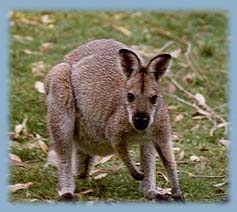
Dingo
The Dingo is a wild dog that inhabits the dry plains and forests of Australia. Scientists are not sure of their origins; they may be the descendants of domesticated dogs brought to Australia over 3,500 years ago. Some Dingos are trained by Aboriginal Australian people as hunting dogs. They also used to be used as living blankets; a cold night was called a "three-dog night."

Platypus
Perhaps one of the quirkiest anomalies ever. It has a duck's bill, webbed feet, a furry body, lays eggs, and yet is a mammal! The female Platypus usually lays two eggs and suckles its young. A male platypus is approximately 50 cm (20 inches) long and weighs 2kg (4 lbs). A female Platypus is approximately 42cm (16.5 inches) long. The male platypus has a poisonous spur on it's hind leg which contains a highly toxic poison. They swim with their eyes closed relying on other senses, and using their bills to stir up the bottom of the river.

Echidna
This little creature sleeps most of the day, and eats ants and termites. They can burrow down into the earth barely moving their bodies, and once burrowed are very difficult to dislodge. They hibernate through the winter and are found throughout Australia.

Wombat (Common)
This is perhaps the prettiest of the wombats! Their status is secure and they grow to 90-120cm (35-47 inches). Unfortunately you most often see wombats as victims of car accidents. The two other members of the wombat family are the Northern Hairy nosed Wombat - now endangered; and the Southern Hairy Nosed Wombat - vulnerable.

Tasmania Tiger
This animal is generally considered to be extinct, however there is still a reward for any information that proves it still exists. There have been numerous reported sightings, but none have developed into anything positive. Many people believe that it still exists in the Tasmanian wilderness, but so far, no proof. It was widely known that the species was endangered and several calls were made to have it protected, but the government of the day refused to take the necessary steps to protect the tiger. The closest living relative is the Tasmanian Devil, which is itself an endangered species.
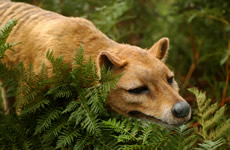
Tasmanian Devil
The Tasmanian Devil is the largest carnivorous (eats meat) marsupial (a mammal that has its babies in a pouch) in Australia. Tasmanian Devils are a nocturnal (active at night) animal. It lives alone and prefers its own company hence it is a relatively shy animal.
The Devil was very popularised by the Bugs Bunny cartoons, however that has not prevented it from becoming an endangered species. Once found throughout most of Australia, it is now limited to the south western districts of Tasmania. It has an eerie growl that starts as a type of whistle. They have very powerful jaws and tend to eat anything that attacks them, leaving virtually nothing behind. They have a life expectancy of about seven years in the wild. They are known as ferocious animals and have very bad tempers! They grow to about 60cm (2 feet).
Goanna
Goannas, or monitors as they are known elsewhere in the world, are a very distinctive group of lizards. They range in size from about 12 cm to 1.3 m, not including the tail. They include the largest lizard living today, the Komodo Dragon of Indonesia.
There are 44 living species of goanna and most of them are carnivores. Goannas find their food by searching widely across the landscape, catching animals by stalking or digging them out of shelters and nests. They are aided in their search for food by their long forked tongues which they flick in and out, picking up chemicals in the air and on the ground. Goannas then "read" these chemicals with a special organ in the roof of the mouth.
Goannas evolved in the northern hemisphere in the Upper Cretaceous Period about 90 million years ago. However, in the Miocene Epoch, about 15 million years ago, goannas moved south into Africa and Australia. In Africa, only a few species evolved, but in Australia, goannas evolved into more than 20 species of which at least one is extinct. Goannas may have evolved in such profusion in Australia because when they arrived, there were relatively few medium-sized carnivores competing for the same resources. Africa, however, had a large number of medium-sized carnivores, especially mammals in the dog and weasel families.
One of the most distinctive features of the evolution of goannas in Australia is that their size range is enormous but their body shape has changed very little over time. The scarcity of competitors provided goannas with an evolutionary opportunity: to stick with one way of making a living and apply it over a range of sizes rather than changing the way of making a living within the same size range.
Thanks to Alan E Greer from the Australian Museum for information.
Blue Tongue Lizard
The Blue-tongued lizard may also called the blue tongue skink. It spends its days eating and sunning itself. At night it rests, sheltered in fallen logs or leaf litter. It is a relatively shy animal, but can put up a bold front when cornered; when threatened, it puffs up its body, sticks out its long, blue tongue, and hisses. The Blue-tongued Skink has a life span of up to 20 years.
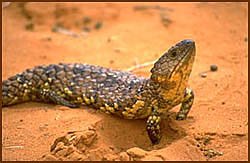
Galah
These are very noisy birds! They live in
huge flocks and are found throughout Australia. It's not at all uncommon to see
a field literally covered in these birds. They have an atypically lazy flight
pattern and one cartoonist always draws them wearing boots. There is a small
town in the Mallee called after them, because of the huge flocks found in the
area.
35cm (14 inches)
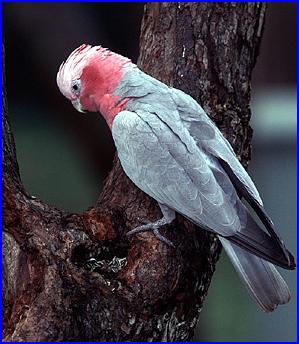
Fairy Penguin
Penguins are only found in the Southern
Hemisphere and the Little Blue (or Fairy Penguin) are found along the shores of
Southern Australia and New Zealand.
Their scientific name is "Eudyptula minor", Eudyptula being Greek for
"good little diver, which is a great description for this smallest species of
penguin Little penguins spend their days out at sea in groups, referred to as
rafts and at dusk they return to their burrows or rock crevice colonies, in
small groups Whilst on land they are very noisy especially before their pre dawn
departure back to sea to feed. These small penguins (16 inches) have a bluish
colour to their upper feathers, and white underbelly , chin and neck and no
ornamental plumage on the head at all. There weight is around the 1kg mark. Like
most penguins their bodies are best described as short and stocky to "chubby".
The Little Penguins short stiff feathers are kept waterproof by preening from
oil glands located at the base of the tail Little penguins do malt though so
their feathers are not always oily smooth.

Cockatoo
These are very noisy, screechy birds, and probably the most well-known of the Australian birds. They are very gregarious and tend to feed in large flocks, and have one or two "lookout" birds watching for danger in high trees. One screech and the flock lifts in unison flashing their yellow underwings. It is a very beautiful sight.
I actually remember once while living in Sydney that about 45 Cockatoo's flocked in my yard and although the sight was beautiful, it became a real pain as they would eat all my plants. I do not know how common this is, however, I am interested to know, so if you have any similar stories to tell, email me and when I get enough, I'll post them here so everyone can have a giggle about these gorgeous birds.
45-50cm (18-19.5 inches)
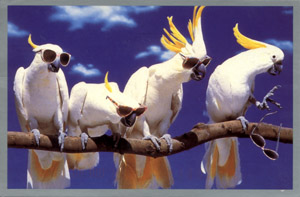
Rosella

Emu
A flightless bird, found throughout
Australia, with the exception of Tasmania.
Average height is 1.6 to 1.9m (5'2" - 6'2") and
weighs up to 45 kilograms (100 lbs)
Females are heavier than males.

Frill Neck Lizard
This sun-loving lizard is the reptile emblem of
Australia, depicted on our now defunct two-cent coin. This reptile is part of
the Dragon family a sub-species of Lizards. They are usually active during the
day and move very fast on their two hind legs.
Head and Body Length: to 28cm Total Overall Length: usually 70 cm but up to
95cm.
The colour of the lizard matches the land on which it lives, so a frilled lizard
from one region may be brighter than another. The male is more colourful than
the female They are not poisonous or harmful to man.

Bilby
There is actually 2 types of Bilby's in
Australia.
Western Bilby (Macrotis lagotis lagotis)
Eastern Bilby (Macrotis lagotis sagitta)
They are a type of Bandicoot (a marsupial), and sometimes are referred to as a
rabbit-eared Bandicoot, Dalgyte, Pinkie, Ninu, Walpajirri or the Greater Bilby.
They are a rabbit size marsupial with large ears (they have great hearing, and the ears also allow the bilby to lose heat, a sort of "thermoregulation") and their fur is soft grey with a bluish tinge. A long pointed snout and a large black and white tail with a white brush tip makes this a striking looking animal. Strong claws enables this marsupial to burrow quickly through sandy soil and the Bilby's pouch faces backwards. Size wise they range from 30 to 60 cm in length with roughly a 20cm tail. The female is smaller than the male, and the species tends to be very solitary.
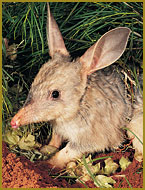
Numbat
The Numbat is also called the Banded Anteater or the Marsupial Anteater because it mainly eats termites or 'white ants' with its very long sticky tongue. Apparently it will eat up to 10,000 a day and it swallows them whole! It is found only in a small area of Western Australia, near Perth, and is an endangered species.

Kookaburra
This is a laughing kookaburra. They are widely spread through the eastern areas of Australia and some parts of WA. They're the largest member of the kingfisher family, and eat other baby birds, frogs, snakes and worms. Their laugh is delightful to hear, except to another kookaburra looking for a nest site, because their laugh is actually a territorial call.
They are approx. 43cm (17 inches).

Magpie
Magpies can be taught to talk, but this involves splitting their tongues, and is quite cruel. They are a very intelligent bird, and are found throughout Australia. One of our major football teams, Collingwood, use their colours and are known as the Magpies.
Magpies are also known to swoop in and 'attack' (peck) people if they think their nests are in jeopardy.
Approx. 38-44cm (15-17 inches)
Great White Shark
The Great White Shark or sometimes called the "Great White" scientific name is Carcharodon carcharias. There are over 600 species of Sharks and rays with the GWS (Great White Shark) belonging to a group of fast-swimming sharks called mackerel sharks. GWS are usually solitary animals but have been seen in pairs and even occasionally in groups up to 7 or 8.

Pademelon
The pademelon (Thylogale
billardierii) is a stocky animal with a
relatively short tail and legs to aid its movement through dense vegetation. It
ranges in colour from dark-brown to grey-brown (below) and has a red-brown belly.
Males, which are considerably larger than females, have a muscular chest and
forearms, and reach up to 12 kg in weight and 1 - 1.2 m in overall length,
including the tail. Females average 3.9 kg in weight.
The unusual common name, pademelon, is of
Aboriginal derivation. It is also sometimes referred to as the rufous wallaby.
Salt Water Crocodile
Crocodiles are different to Alligators (there are no Alligators found naturally in Australia), and the salt-water Crocodile is a very dangerous creature. In fact, very often they are considered to be the most dangerous of all the reptiles. They do attack people, including people in boats, so they are definitely worthy of a cautious respect. Although they might seem clumsy on land, they are highly agile in the water. They were hunted almost to extinction in the late 1960's, but have recovered to the point where they are not considered at all endangered.

Yabby
Yabbies, are a type of inland freshwater
crayfish found in Australia. They are a crustacean (External skeleton = hard
shell). Scientific name is "Cherax destructor". Smooth shells and a range of
colours depending upon the colour of their habitat (mud silt water etc). Their
colour therefore ranges from greens to yellows, browns to blacks and red or
blue. Mostly though the colours are drab due to them being found mostly in mud
and silt. Yabbies usually grow to a length of up to 150 mm depending upon
conditions. They have eyes on the end of little stalks. They also have 3 sets of
antennae which provide the yabby with the ability to touch things. Yabbies have
gills like fish so they can "breathe" under water like most crayfish. The
yabbies have 2 large "pincer like" claws at the front. These are used mainly for
defence against other Yabbies and predators as well as for grasping food, and
for digging burrows. Yabbies have 4 sets of "walking legs and a long thick
"tail".

Pelican
The Australian Pelican (Pelecanus
conspicillatus) is found all around Australia and is the biggest of the 8
species of Pelicans found worldwide. Pelicans as a whole are big birds with a
very large wingspan, large beaks and are very well known. One of the reason such
a big bird can fly is that its skeleton is very light (10% of their weight).
Australian Pelicans are white in colour with black wingtips and black markings
on their tail. Behind their head and part way down their neck there is a
"streak" of grey. Their bill and very large bill pouch are pink and is the
longest beak/bill of any, of all the types of Pelicans in the world , whilst
their legs and feet are blue-grey in colour.
They are so buoyant they cannot sink under water, though unlike most water birds
they do not have a lot of water proof oil on their feathers so they can get wet
and cold.

Red Bellied Black Snake
This snake averages 1.5 to 2 metres in length. Though venomous and potentially able to inflict a fatal bite, this is a very inoffensive snake which will move away from potential attackers or bluff with a threatening display. There are no known human fatalities attributed to this snake. Litters of 5 to 40 live young are born around February to April. Each juvenile is born in a membranous sac which it leaves shortly after birth. Frogs, fish, reptiles and small mammals make up the diet of the Red Bellied Black Snake.
The below websites are highly recommended by Just Oz.
We apologise for not listing every Australian animal here, but we are sure you will find everything you need to know about Australian Wildlife from the Unique Australian Animals website and Ozwildlife website.
A big thank you to JP from Ozwildlife for allowing us to use some of his images.
![]()